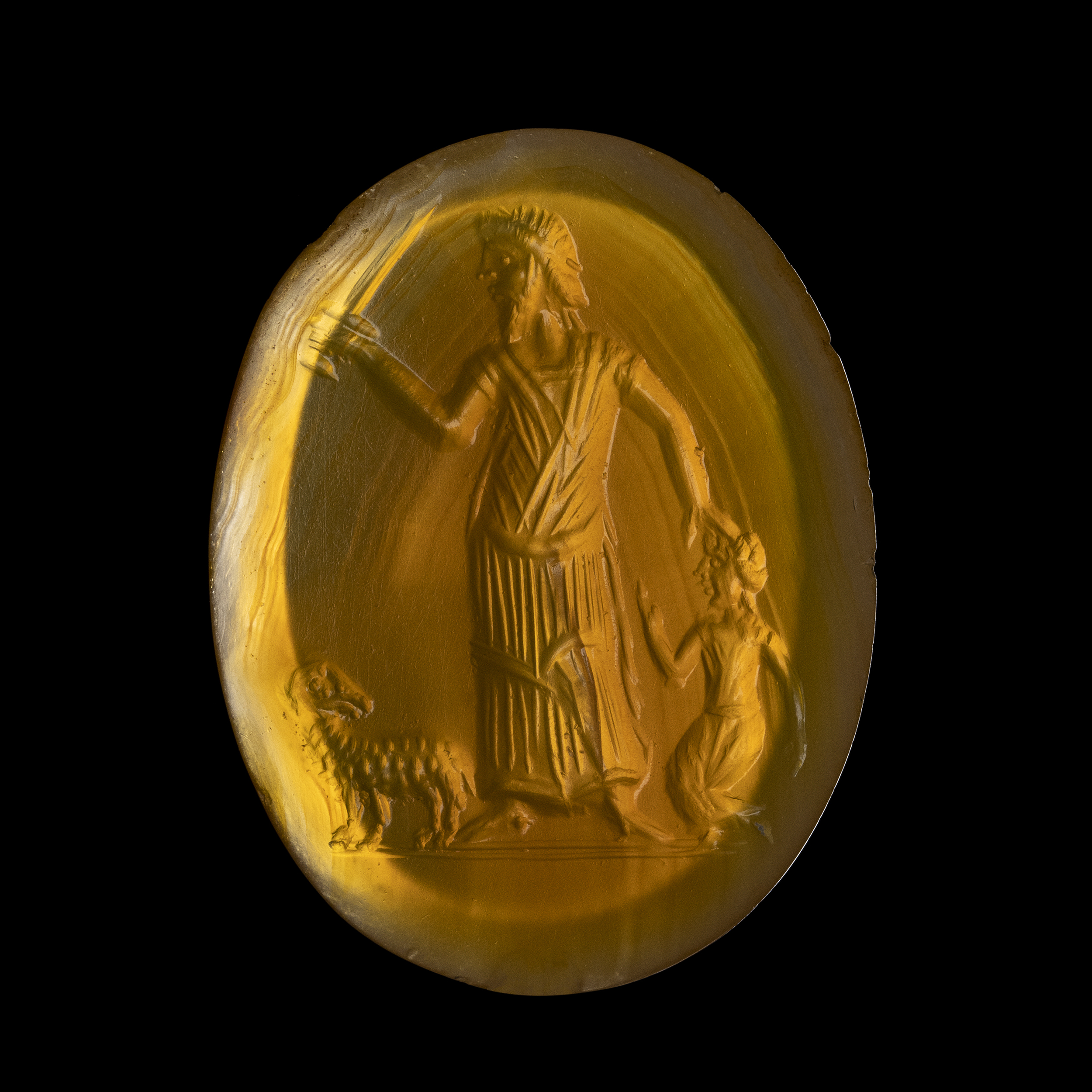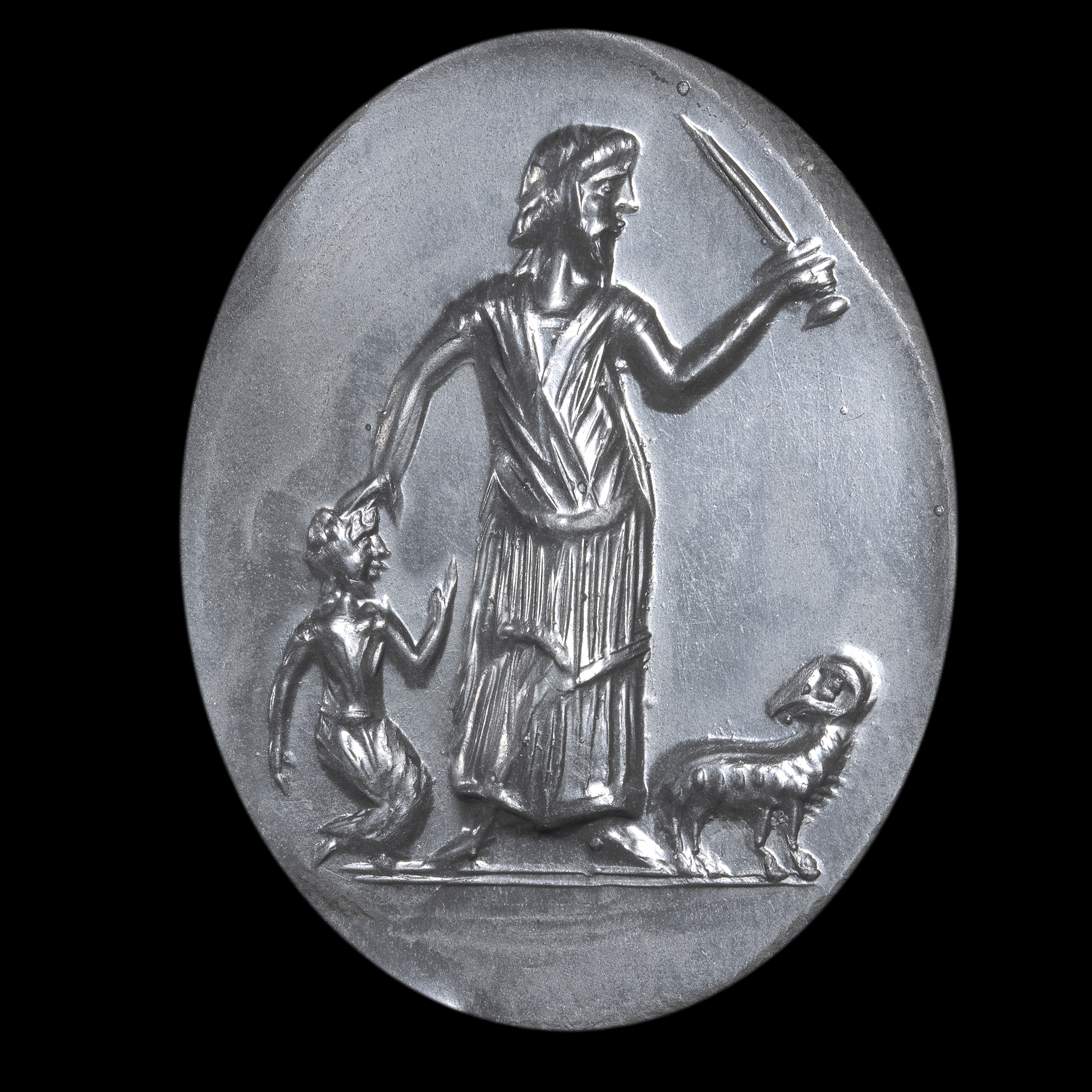sur agate figurant le Sacrifice d'Abraham (Gen.22,1-18).
La scène se compose d'un personnage masculin central d'âge mûr, Abraham, debout, vêtu d'une longue tunique, le corps de face et le visage de profil v. la gauche. De sa main droite, il tient une courte épée, tandis-que de sa main gauche il retient à terre son fils Isaac.
A ses pieds à gauche, un bélier. Ligne de base.
Cette iconographie a une grande importance dans l'élaboration de la foi dans les premiers temps chrétiens; comme le Christ, Isaac était un fils unique aimé de son père, et prêt à être sacrifié. Dans les deux cas, le lieu du sacrifice fut le sommet d'un mont. Signa Isaac sibi vexit, Christus sibi patibulum crucis portavit. les épines du buisson dans lequel le bélier était pris représentaient les épines du Christ. Une scène aussi importante pour l'Eglise a eu donc de nombreuses représentations dans l'art Chrétien sur de nombreux monuments; des fresques, mosaïques, sarcophages, verres, desgemmes et des lampes.
Dans le cas présent, la composition de la scène est à rapprocher du "type hellénistique" caractérisé par une représentation simple et épurée que l'on retrouve notamment sur les sarcophages romains (fig.1). Dans ce cas de figure, Abraham est vêtu d'une simple tunique et du pallium. Il est barbu, tenant le couteau dans sa main droite, tandis-que le gauche retient la tête d'Isaac, à genoux à terre. Frequemment, la main de Dieu est intriduite, dans ce cas, Abraham tourne sa tête vers elle (cf. Sarcophage du Latran du cimetière de Lucina, n°59), et la présence invariable du bélier.
Ce type de représentation trouve son origine dans les catacombes de Rome, et correspondrait à la version occidentale du "type hellénistique".
28 x 37 x 4 mm
Art tardo-romain, IVe siècle
Provenance
Collection privée française, constituée dans les années 1980-1990
Pour une iconographie similaire
Sarcophage en marbre figurant le Sarcifice d'Abraham, Musée Archéologique de Cordoba, Espagne (fig.2)
Sarcophage en marbre de Junius Bassus portant la date de 359, Saint-Pierre, Musei Vatican (fig.3)
mosaïque byzantin de la Basilique de San Vitale à Ravenne en Italie (fig.4)
A late Roman large agate intaglio depicting the Sacrifice of Abraham. 4th century A.D.
The scene consists of a middle-aged central male figure, Abraham, standing, dressed in a long tunic, the body in front and the face in profile c. left. In his right hand he holds a short sword, while in his left hand he holds his son Isaac down.
At his feet on the left, a ram. Baseline.
This iconography has great importance in the elaboration of faith in early Christian times; like Christ, Isaac was an only son loved by his father, and ready to be sacrificed. In both cases, the place of sacrifice was the top of a mountain. Signed Isaac sibi vexit, Christus sibi patibulum crucis portavit. The thorns of the bush in which the ram was caught represented the thorns of Christ. A scene so important for the Church has therefore had many representations in Christian art on many monuments; frescoes, mosaics, sarcophagi, glasses, gems and lamps.
In the present case, the composition of the scene is to be compared to the "Hellenistic type" characterized by a simple and refined representation that is found in particular on Roman sarcophagi (fig.1). In this case, Abraham is dressed in a simple tunic and the pallium. He is bearded, holding the knife in his right hand, while the left holds Isaac's head, kneeling on the ground. Frequently, the hand of God is introduced, in this case, Abraham turns his head towards it (cf. Lateran sarcophagus of the cemetery of Lucina, n°59), and the invariable presence of the ram.
This type of representation finds its origin in the catacombs of Rome, and would correspond to the Western version of the "Hellenistic type".
Description complète










